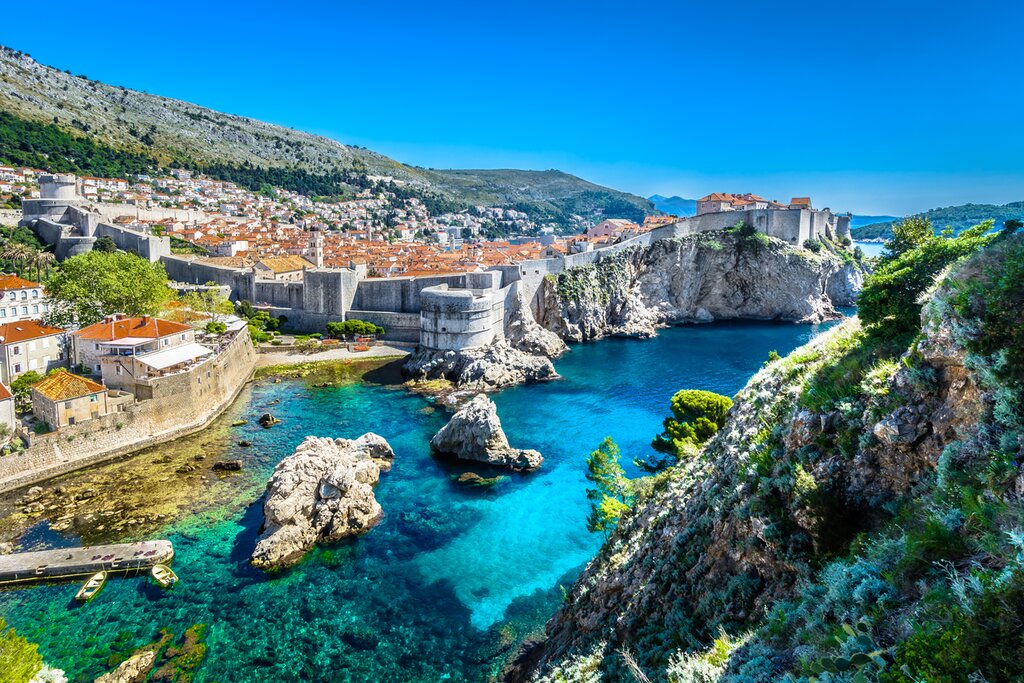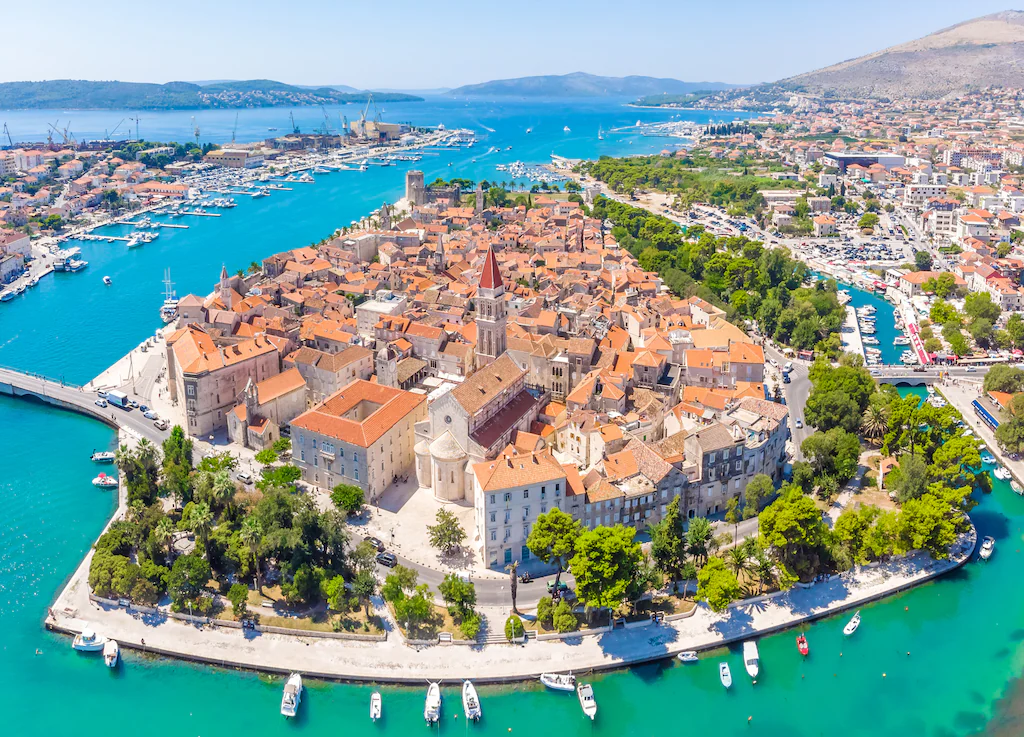



Split, historically known as Spalato, is the second-largest city of Croatia after the capital Zagreb, the largest city in Dalmatia and the largest city on the Croatian coast. The Split metropolitan area is home to about 330,000 people. Wikipedia
May–June & September–October: Ideal weather, fewer tourists, warm sea
July–August: Peak season; vibrant nightlife and festivals, but hot and crowded
November–April: Quieter and budget-friendly; fewer ferries and some attractions close early
By Air:
Split Airport (SPU), ~25 km from the city
Direct flights from many European cities in summer
Shuttle bus, taxi, or Uber to the city center
By Ferry:
From Dubrovnik, Hvar, Korčula, and even Italy (Ancona)
Main ferry terminal is right next to the Old Town
By Bus or Train:
Regular buses from Zagreb, Dubrovnik, Zadar
Split has a train station near the ferry port (but rail options are limited)
By Car:
Scenic Adriatic coastal roads or faster via A1 highway
Ancient Roman palace (built 4th century AD)
Not a museum—people live and work in it!
Wander through its cellars, temples, gates, and hidden courtyards
Originally Diocletian’s mausoleum
Climb the bell tower for epic views of the city and sea
Stunning central courtyard of the palace
Great for people-watching and live music in the evenings
Palm-lined seafront walkway with cafés and bars
Best spot for a sunset stroll or cocktail
Popular sandy beach just 10 mins from Old Town
Locals play picigin (a unique ball game) here
Lush park with hiking trails and panoramic views
Hidden beaches and old chapels scattered along the trails
Great for history lovers wanting deeper insights into Split’s Roman and medieval past
Explore local markets: Pazar (green market) and Peškarija (fish market)
Take a boat tour to Blue Lagoon, Hvar, or Krka National Park
Try a day trip to Trogir, a nearby historic town (UNESCO-listed)
Enjoy local nightlife in Diocletian’s Palace cellars or clubs near Bačvice
Attend a klapa (a capella) concert or a summer music festival
Hotel Park Split – beachfront luxury near Bačvice
Judita Palace Heritage Hotel – 4-star charm inside Diocletian’s Palace
Cornaro Hotel – upscale, central, with rooftop bar
Hotel Luxe – stylish hotel with views of the harbor
Divota Apartment Hotel – boutique apartments in Veli Varoš
Hostel Split Backpackers – social and central
Design Hostel Goli & Bosi – funky, well-located hostel
Pasticada – slow-cooked beef stew with gnocchi
Crni rižot – black risotto with cuttlefish ink
Grilled fish, olive oil, and local wine
Fritule – fried dough balls with sugar, like mini doughnuts
Bokeria Kitchen & Wine – Mediterranean fusion
Konoba Fetivi – traditional Dalmatian seafood and vibe
Zinfandel Food & Wine Bar – modern dishes and great wine list
Villa Spiza – cozy and beloved by locals
Dvor – upscale with sea views
Kavana Procaffe – lovely seaside café
Bobis – classic bakery chain for pastries
4Coffee Soul Food – tiny spot with the best espresso in town
Pasticada – slow-cooked beef stew with gnocchi
Crni rižot – black risotto with cuttlefish ink
Grilled fish, olive oil, and local wine
Fritule – fried dough balls with sugar, like mini doughnuts
Bokeria Kitchen & Wine – Mediterranean fusion
Konoba Fetivi – traditional Dalmatian seafood and vibe
Zinfandel Food & Wine Bar – modern dishes and great wine list
Villa Spiza – cozy and beloved by locals
Dvor – upscale with sea views
Kavana Procaffe – lovely seaside café
Bobis – classic bakery chain for pastries
4Coffee Soul Food – tiny spot with the best espresso in town
Laid-back Mediterranean lifestyle: locals love coffee, slow meals, and seaside walks
Split’s soul is tied to Diocletian’s Palace—every corner has a Roman or Venetian story
Football passion: Hajduk Split is a religion, not just a team
Picigin: a ball game played in shallow waters, uniquely Split
Split is the heart of Dalmatia, a region known for its seafaring heritage, Mediterranean lifestyle, and strong community values.
Built around the ancient Diocletian’s Palace (4th century AD), the city has been continuously inhabited for over 1,700 years.
Locals are known as Splićani—proud, outspoken, humorous, and warm-hearted.
Language: Croatian (with a distinctive Dalmatian accent and slang)
Common phrases:
Dobar dan – Good day
Fala (local dialect of Hvala) – Thank you
Pomalo – “Take it easy” (a Dalmatian life philosophy)
Most young people speak English, especially in tourism areas.
Coffee is a social ritual, not just a caffeine fix.
Locals often spend hours at cafés on the Riva promenade, watching people and chatting.
Don’t be surprised if a 30-minute coffee date lasts two hours.
Klapa: traditional a cappella singing, rooted in love, the sea, and local stories
Often performed at festivals, weddings, and even informally on the streets
Hajduk Split is a huge part of local identity.
Fans (known as Torcida) are fiercely loyal, and matches at Poljud Stadium are an intense cultural experience.
Split Summer Festival: Classical concerts, opera, and dance in historic venues like the Peristyle
Days of Diocletian (August): Locals wear Roman costumes, reenact history, and celebrate ancient heritage
Ultra Europe Music Festival: One of Europe’s biggest EDM festivals (held in July)
Rooted in fresh, seasonal, and local ingredients
Daily green and fish markets are social and essential
Meals are relaxed and social events, often with homemade wine or rakija (fruit brandy)
Local artisans produce:
Olive oil and lavender-based products
Filigree silver jewelry
Handmade leather sandals (popular on the Riva)
Life revolves around the sea—fishing, sailing, and ferry travel are second nature
Many families have boats or coastal cottages on nearby islands
Predominantly Catholic with active participation in festivals and saints’ days
Saint Domnius (Sveti Duje) is the city’s patron saint; his feast day (May 7) is celebrated with parades, mass, and public events
Friendly but direct—locals will speak their mind, but always with warmth
Hospitality is strong—expect homemade treats and drinks if you visit someone’s home
Dress modestly in churches; casual but neat in daily life